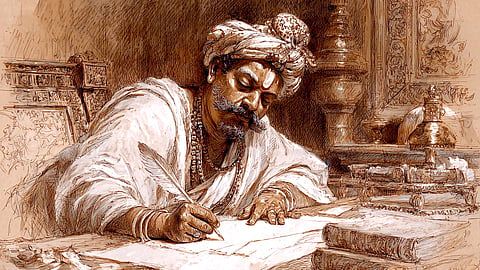- Commentary
- History Vignettes
- Notes on Culture
- Dispatches
- Podcasts
- Indian LanguagesIndian Languages
- Support

ANOTHER EYE-OPENING EPISODE occurs in the regime of Maharaja Pasenadi of the Aikṣvāka dynasty ruling from Shravasti. He made a public announcement of his proposal to marry a princess of the Sakya clan. Following this, members of the Sākya clan met in their own Sanghahara (Assembly) to discuss the proposal. This episode opens up two important insights:
1. Each clan or Gana had its own Assembly Hall apart from the common Sanghaghara.
2. The importance that the general public attached to even the private affairs of their ruler.
The importance of the second point cannot be underemphasised. Why was it necessary for the people to give their approval for the ruler’s marriage? The answer: our political philosophers and Rishis right from the Vedic age understood that running a society and thereby a country was essentially the delicate art of maintaining a fine balance. They had grasped the fundamental human impulse that the moment one group in a society gains disproportionate power, the entire structure will collapse sooner than later.
The best example of how things can go horribly wrong is available right before our eyes: the marriage of an Italian lady to the son of a former Prime Minister of India. Did Indira or Rajiv Gandhi seek permission of the Indian people before embarking on such a sensitive decision that would have far-reaching ramifications for national security?
We also observe the same practice in various Hindu kingdoms throughout our history. I’ll give some random examples.
First we have the celebrated Samudragupta, the younger son of Chandragupta I. He was nominated as the successor setting aside the king’s eldest son. The fact that his succession caused no royal split or factional war is remarkable. Then we have the great example of the young boy Harshavardhana who was elected as King by the people after his elder brother Rajyavardhana was murdered. Similarly, after Pallava Parameshwaravarman was killed in battle, the new king Nandivarman II was elected. We also have Harihara I who nominated his brother instead of his son; and even as recent as the 17th century, the Tanjavur Nayaka, Venkata II nominated his nephew Chikka Raya as the king.
The uniform theme in all these cases was the fact that public opinion was not violated even by the highest political institution of the land. Indeed, in some cases, public opinion endorsed the choice of the ruler.
The next institution in importance is the administrative apparatus. Our civilizational continuity is perhaps best seen in this area, all the way from the Ramayana and the Mahabharata era up to the famous Ashta-Pradhan system of the Maratha Empire. We have literally hundreds if not thousands of examples from Hindu history that proves this.
Let’s take the second Adhikarana of the Arthasastra. This Adhikarana has a term, Adhyaksha-pracara, or Duties of Superintendents. We see a direct usage of this same term in a 11th Century inscription found at a village named Belava, near Dhaka. It talks about a donation granted by a Pala feudatory, Bhojadeva Varman and it reads, “अन्यांश्च सकलराजपादोपजीविनः अध्यक्षप्रचारोक्तान् (sakalarājapādopajīvinaḥ adhyakṣapracāroktān).” These exact words appear in another 11th century grant by the Sena ruler, Vijaya Sena, found at Barrackpore.
If this is on one side, we have yet another incredible grant of his son, Ballalasena, which gives a long list of Government officials in his administration at various levels. Here’s the list: rājanyaka, rājñī, raṇaka, rājaputra, rājāmātya, purohita, mahādharmadhyakṣa, mahāsandhivigrahaka, mahāsenapati, mahāmudrādhikāri, antaraṅga-bṛhaduparika, mahākṣapāṭalika, mahāpratihāra, mahābhogika, mahāpilupati, mahāgaṇastha, cauroddharaṇika, naukābalahastyaśvagomahiśājāvika, divayāpṛtaka, gaulmika, daṇḍapaśika, daṇḍanāyaka, viṣayapati. This number is exactly 28. This list concludes with the same words: सकलराजपादोपजीविनः अध्यक्षप्रचारोक्तान् — sakalarājapādopajīvinaḥ adhyakṣapracāroktān.
Now, let’s travel from Bengal to Devagiri in the same 11th century and look at a miniature portrait of the Yadava or Sevuna administrative setup. Their ministry consisted of seven officers namely: Premier (Mahapradhana), the Foreign Minister (sandhvigrahi), the Revenue Minister (Maha-Amatya), the War Minister (Mahaprachanda-dandanayaka), and the Chief Secretary (patalakarani). Other ministers included Ecclesiastical Minister (Pandita) and the Judicial Minister (pradvivadaka). Notice the similarities, the same unbroken features?
We also notice other eye-opening facts in this study. This time, let’s take the example of the legendary Hemadri (or Hemad-Pant as he’s fondly known to the Marathi people), the prolific author of Chaturvarga Chintamani, an encyclopedic work on Dharmasastra. By profession, he was the head of the elephant squadron and was later promoted as the chief secretary of the Yadava kingdom. He is variously described as a great warrior and like Parashurama, he was adept in practicing the famous motto…shaapadapi sharaadapi (expert in both Sastra and archery). He is described as being “skilled in political science as Vishnugupta (Kautilya), and as efficient in destroying the enemy as Yama.” In fact, we can write a well-researched work about the life and achievements of such extraordinary ministers and bureaucrats working in all major Hindu Empires… other names of similar eminence include Chavundasetti, Madiraja, Basavarasa, Mahadandanayaka Hariyappa Odeya, Mahamantri Timmarasu.
To be continued
The Dharma Dispatch is now available on Telegram! For original and insightful narratives on Indian Culture and History, subscribe to us on Telegram.
